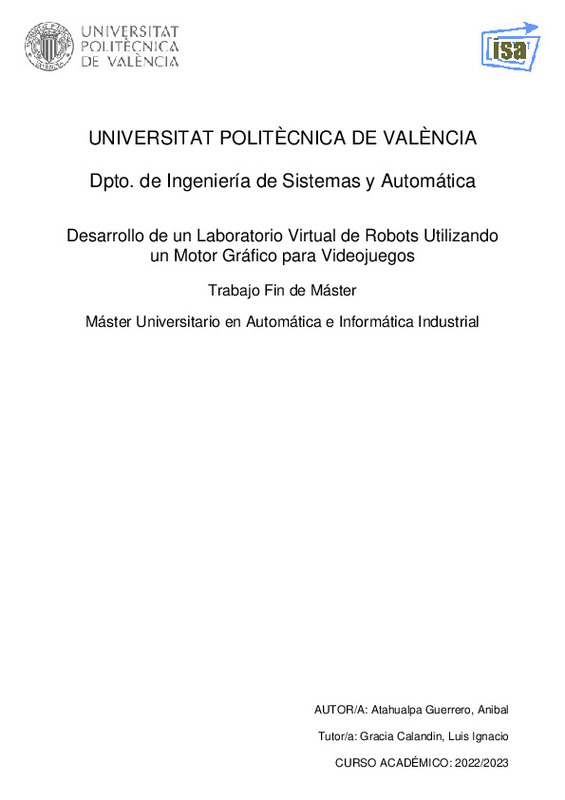|
Resumen:
|
[ES] En el presente trabajo se documenta el desarrollo de un entorno virtual de simulación en tiempo real para aplica-ciones robóticas, que aprovecha, por una parte, las funciones y herramientas del sistema ROS (Robotic ...[+]
[ES] En el presente trabajo se documenta el desarrollo de un entorno virtual de simulación en tiempo real para aplica-ciones robóticas, que aprovecha, por una parte, las funciones y herramientas del sistema ROS (Robotic Operating System) y el motor gráfico para videojuegos de Unreal Engine 5. Se realiza una integración entre ROS y Unreal a partir del desarrollo de una API en Python que utiliza la librería ROSLIBPY para conseguir la comunicación en tiempo real entre ambos entornos usando websockets. La API ha sido desarrollada implementando un framework conocido como FASTAPI. El producto del desarrollo se ha nombrado UROS API (Unreal - ROS - API). El software (UROS API) desarrollado en el presente trabajo se ejecuta gracias a Uvicorn un servidor ASGI (Asyn- chronous Server Gateway Interface), la API permite gestionar las comunicaciones, también con clientes web, como punto de partida para la transición que los sistemas industriales requieren en relación con los cambios que se producen en la llamada industria 4.0. Para ello, se desarrolló una aplicación web utilizando el framework React.js y Vite que consume la API y los datos que se obtienen de los tópicos de ROS. Esta aplicación web se ha nombrado (UROS APP) y permite interactuar de forma gráfica con la API desarrollada. UROS API es capaz de almacenar los datos obtenidos de cada tópico en ROS en colecciones dentro de una base de datos NoSQL como MongoDB y UROS APP es capaz de visualizar esta información utilizando Chart.js como librería para gráficos. El entorno se ha construido a partir de recursos y modelos 3D libres disponibles en línea y en el marketplace de Unreal Engine. Se realizaron las configuraciones de los modelos 3D creando clases con blueprints, que es el lenguaje gráfico de programación en el entorno de Unreal Engine. De esta manera, los robots simulados usan juntas con restricciones físicas para cada unión entre cuerpos rígidos, formando sistemas que describen el comportamiento y movimiento real de los sistemas robóticos que se evalúan en el entorno. Finalmente Se llevaron a cabo pruebas genéricas de comunicación y control simple de los sistemas, control manual de teleoperaciones en un robot sumo de dos ruedas. Y una tarea de pick and place en un robot industrial con 6 grados de libertad.
[-]
[CA] This paper documents the development of a virtual real-time simulation environment for robotic applications.
This paper documents the development of a virtual real-time simulation environment for robotic applications, ...[+]
[CA] This paper documents the development of a virtual real-time simulation environment for robotic applications.
This paper documents the development of a virtual real-time simulation environment for robotic applications, which uses, on the one hand, the functions and tools of the ROS (Robotic Operating System) and the Unreal Engine 5 graphics engine for video games.
System) and the Unreal Engine 5 graphics engine for video games.
An integration between ROS and Unreal is carried out based on the development of an API in Python that uses the library
ROSLIBPY library to achieve real-time communication between both environments using websockets. The API has been
developed by implementing a framework known as FASTAPI. The development product has been named
UROS API (Unreal - ROS - API).
The software (UROS API) developed in the present work is executed thanks to Uvicorn, an ASGI server (Asyn-
chronous Server Gateway Interface) server, the API allows to manage communications, also with web clients, as a starting point for the transition that the
The API makes it possible to manage communications, also with web clients, as a starting point for the transition that industrial systems require in connection with the changes occurring in the so-called Industry 4.
changes brought about by the so-called Industry 4.0. For this purpose, a web application was developed using the React.js framework and Vite
that consumes the API and the data obtained from the ROS topics. This web application has been named (UROS
APP) and allows to interact graphically with the developed API.
UROS API is able to store the data obtained from each topic in ROS in collections within a NoSQL database such as MonoSQL.
NoSQL database such as MongoDB and UROS APP is able to visualise this information using Chart.js as a
charting library.
The environment has been built from free resources and 3D models available online and in the marketplace of
Unreal Engine marketplace. The 3D model configurations were made by creating classes with blueprints, which is the graphical programming language in the Unreal Engine environment.
The 3D models were set up by creating classes with blueprints, which is the graphical programming language in the Unreal Engine environment. In this way, the simulated robots use joints with physical constraints for each
physical constraints for each joint between rigid bodies, forming systems that describe the real behaviour and movement of the robotic systems.
and movement of the robotic systems that are evaluated in the environment.
Finally, generic tests of communication and simple control of the systems were carried out, control
manual control of teleoperations on a two-wheeled sumo robot. And a pick and place task on an industrial robot with 6 degrees of freedom.
with 6 degrees of freedom.
[-]
|







